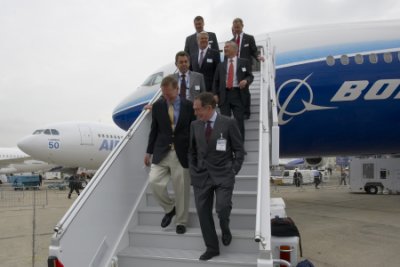With orders back in fashion, it was just like old times at Paris
It was a tender moment. An Airbus delegation led by a grinning chief executive Noel Forgeard is photographed being led down the steps of the Boeing 777-200LR on the static display at Le Bourget by Forgeard’s counterpart at Boeing Commercial Airplanes (BCA), Alan Mulally, with his senior colleagues. Airbus returned the favour by inviting the Boeing team onboard the A380. For all that this year’s Paris air show was meant to be about gladitorial combat between the two giants of the aerospace industry, in the event little blood was spilt, with both appearing relieved that the cake they have been fighting over is getting bigger by the week.

The expected no-holds-barred scrap over state aid became a rather flat affair, Airbus having decided to shelve the launch of the A350 for three months as the dispute starts to make its lumbering way through the World Trade Organisation (WTO). Rather than trading punches, both sides kept emphasising that they hoped a compromise could be agreed.
In terms of big visual statements, Airbus, of course, stole the show with the A380’s maiden Paris display, Boeing choosing as ever not to fly its flagship product, the 777-200LR. The fact that the world’s big two aerospace companies went into Paris minus chief executives failed to be much of an issue either – EADS co-chief executive-in-waiting Forgeard still insisting he was very much in charge at subsidiary Airbus, and Mulally, a contender for the top job at Boeing, also strictly sticking to the script as head of BCA.
On orders, both manufacturers had an exceptionally strong Paris. Although Qatar Airways’ announcement that it was “to order” 60 A350s was not strictly a contract – there were rumours that behind-the-scenes pressure had been applied to ensure Airbus hit its predicted 100 orders at Paris – while Boeing “lost” an Air Canada commitment for 777s and 787s just as the show ended, healthy backlogs and delivery predictions for 2007 have sent both Boeing and EADS shares soaring in recent weeks. It seems that, so far as investors are concerned, unfilled orderbooks are more of a worry than unfilled chief executive chairs. It also proves that, despite efforts by Boeing and EADS to diversify their businesses, it is still the fortunes of the commercial airline market that dictate the value of both companies.
With more orders coming at Paris from the likes of start-up Kingfisher Airlines and Jet Airways, the main worry for the big two might in fact be their exposure to the Middle East and Indian markets. Both regions have potential for instability and their rapidly-expanding airlines’ ambitions may prove to be out of kilter with what their markets can support.
The other two main airliner manufacturers, Bombardier and Embraer, had a quieter Paris, with the Canadian company also having to shelve any plans it might have had to launch its CSeries at the show. If the mainline airliner is eventually given the green light, it will antagonise Airbus and Boeing as much as its traditional Brazilian adversary, and all three companies could join forces to take the row over government launch aid for the programme to the WTO.
The next Farnborough or Paris show could see the focus shift to the engine manufacturers as the big three, and their smaller Japanese and European partners, jostle to power the successors to the Airbus A320 and Boeing 737 families.
On the defence side, unmanned air vehicles again made a significant impact at Paris, with the unveiling of a model of the European Neuron unmanned combat aircraft vehicle demonstrator by Dassault and continuing debate about industrial participation in the programme. While Lockheed Martin continues to talk up its F-35 Joint Strike Fighter, backlogs for the USA’s legacy fighters are getting perilously small. Ironically, among the biggest hopes for keeping production lines going are India and Pakistan – until recently pariah states in the eyes of the USA after they developed and tested nuclear weapons.
The shape of the industry’s big get-togethers has changed too. This year’s Paris – at which US industry was back in force after the Iraq rift of 2003 – was a day shorter than previously, with the week compressed into four rather than five business days, a move which was welcomed by exhibitors and visitors alike.
Next year’s Farnborough air show is taking a similar tack and used Paris to launch its new template – which it says is in response to feedback from industry.
Despite making efforts to shore up their business aviation representation, both main shows appear to be fighting a losing battle against the success of the dedicated European Business Aviation Convention and Exhibition in Geneva. Paris witnessed the first public display of the Dassault Falcon 7X long-range business jet – in front of its home crowd – and the surprise revelation of an all-new utility jet from German manufacturer Grob. But there was little else to appeal to the business and general aviation community.
MURDO MORRISON & GRAHAM WARWICK
Source: Flight International





















